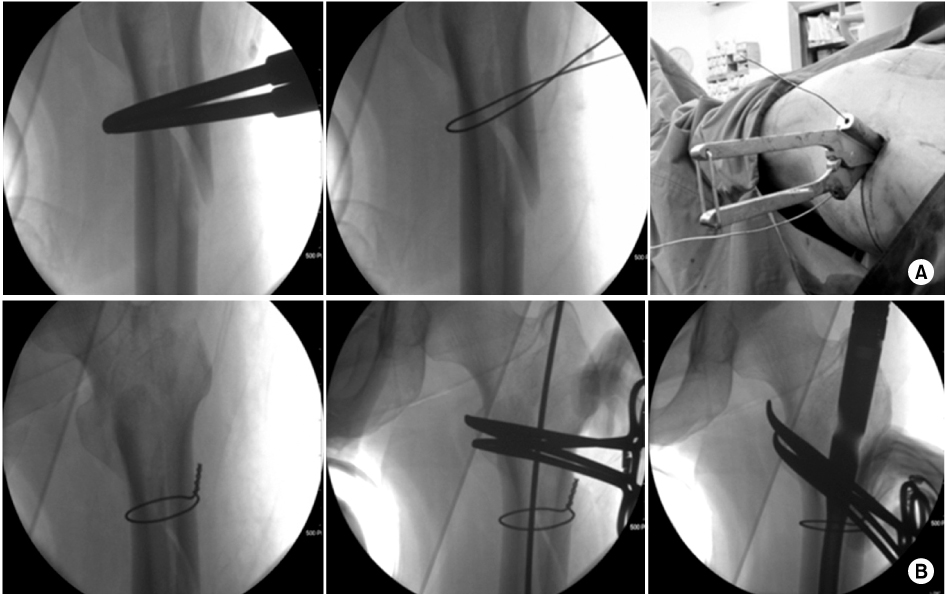Articles
- Page Path
- HOME > J Musculoskelet Trauma > Volume 26(3); 2013 > Article
-
Surgical Technique
- Efficacy of Percutaneous Cerclage Wiring in Intramedullary Nailing of Subtrochanteric Femur Fracture: Technical Note
- Ki-Chul Park, M.D., Hee-Soo Kim, M.D.
-
Journal of the Korean Fracture Society 2013;26(3):212-216.
DOI: https://doi.org/10.12671/jkfs.2013.26.3.212
Published online: July 15, 2013
Department of Orthopedic Surgery, Guri Hospital, Hanyang University College of Medicine, Guri, Korea.
- Address reprint requests to: Ki-Chul Park, M.D. Department of Orthopedic Surgery, Hanyang University Guri Hospital, 153 Gyeongchun-ro, Guri 471-701, Korea. Tel: 82-31-560-2316, Fax: 82-31-557-8781, kcpark@hanyang.ac.kr
• Received: March 8, 2013 • Revised: April 15, 2013 • Accepted: April 28, 2013
Copyright © 2013 The Korean Fracture Society. All rights reserved.
This is anOpen Access article distributed under the terms of the Creative Commons Attribution Non-Commercial License (http://creativecommons.org/licenses/by-nc/3.0/) which permits unrestricted non-commercial use, distribution, and reproduction in any medium, provided the original work is properly cited.
- 135 Views
- 2 Download
- 2 Crossref
Figure & Data
REFERENCES
Citations
Citations to this article as recorded by 

- The stabilising effect by a novel cable cerclage configuration in long cephalomedullary nailing of subtrochanteric fractures with a posteromedial wedge
Pavel Mukherjee, Jan Egil Brattgjerd, Sanyalak Niratisairak, Jan Rune Nilssen, Knut Strømsøe, Harald Steen
Clinical Biomechanics.2019; 68: 1. CrossRef - Factors Affecting Time to Bony Union of Femoral Subtrochanteric Fractures Treated with Intramedullary Devices
Jung-Yoon Choi, Yerl-Bo Sung, Jin-Hee Yoo, Sung-Jae Chung
Hip & Pelvis.2014; 26(2): 107. CrossRef
Efficacy of Percutaneous Cerclage Wiring in Intramedullary Nailing of Subtrochanteric Femur Fracture: Technical Note



Fig. 1
Surgical technique.
(A) Closed reduction by percutaneous cerclage wiring.
(B) Nail insertion.
Fig. 2
(A) A 32-year-old man's radiographs demonstrating Arbeitsgemeinschaft für Osteosynthesefragen and Orthopaedic Trauma Association (AO/OTA) type 32-B1 subtrochanteric femur fracture.
(B) Anteroposterior and lateral radiographs of the same patient 5 months postoperatively.
(C) Postoperative functional photograph.
Fig. 3
(A) A 55-year-old man's radiographs demonstrating Arbeitsgemeinschaft für Osteosynthesefragen and Orthopaedic Trauma Association (AO/OTA) type 32-B1 subtrochanteric femur fracture.
(B) Intraoperative radiograph shows cerclage wiring and clamp assisted reduction.
(C) Radiograph at 6 months after surgery shows solid bony union.
Fig. 1
Fig. 2
Fig. 3
Efficacy of Percutaneous Cerclage Wiring in Intramedullary Nailing of Subtrochanteric Femur Fracture: Technical Note

 E-submission
E-submission KFS
KFS



 Cite
Cite

